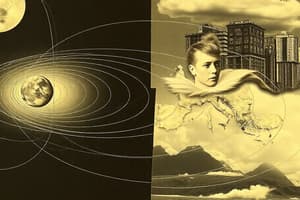Podcast
Questions and Answers
Which of the following best explains why the Intertropical Convergence Zone (ITCZ) is characterized by very little wind?
Which of the following best explains why the Intertropical Convergence Zone (ITCZ) is characterized by very little wind?
- The prevailing westerlies dominate the area, creating stable atmospheric conditions.
- The convergence of the polar easterlies creates a high-pressure zone, suppressing wind activity.
- The Coriolis effect is strongest at the Equator, deflecting winds away from the area.
- The trade winds converge at the Equator and rise upwards due to high solar heating. (correct)
If a ship is located at 45° south latitude, in which direction would it primarily need to sail to take advantage of the prevailing winds for a faster journey eastward?
If a ship is located at 45° south latitude, in which direction would it primarily need to sail to take advantage of the prevailing winds for a faster journey eastward?
- Slightly north-west, to catch the north-westerly winds. (correct)
- Slightly south-west, to catch the south-westerly winds.
- Slightly south-east, to catch the south-easterly trade winds.
- Slightly north-east, to catch the north-easterly polar winds.
Consider a location at 75° north latitude. How would you characterize the general wind patterns and pressure systems typically found in this region?
Consider a location at 75° north latitude. How would you characterize the general wind patterns and pressure systems typically found in this region?
- Strong westerlies and a high-pressure zone.
- Weak and variable winds with frequent low-pressure systems.
- Strong easterlies and a high-pressure zone. (correct)
- Strong westerlies and a low-pressure zone.
How do the locations of the Hadley, Ferrel, and Polar cells contribute to the distribution of deserts and rainforests on Earth?
How do the locations of the Hadley, Ferrel, and Polar cells contribute to the distribution of deserts and rainforests on Earth?
If a sailor from the 17th century wanted to sail from Europe to the Americas to trade and then return to Europe, which wind patterns would they most likely utilize, and in what order?
If a sailor from the 17th century wanted to sail from Europe to the Americas to trade and then return to Europe, which wind patterns would they most likely utilize, and in what order?
Assuming there is no landmass, What would be the most likely effect of a significant weakening of the Ferrel cell on global wind patterns?
Assuming there is no landmass, What would be the most likely effect of a significant weakening of the Ferrel cell on global wind patterns?
How do the permanent pressure zones and prevailing winds influence ocean currents, and what is one significant consequence of this interaction?
How do the permanent pressure zones and prevailing winds influence ocean currents, and what is one significant consequence of this interaction?
How does differential heating of the Earth contribute to the formation of global wind patterns?
How does differential heating of the Earth contribute to the formation of global wind patterns?
Which of the following best describes the relationship between pressure belts and prevailing winds?
Which of the following best describes the relationship between pressure belts and prevailing winds?
What effect does the Intertropical Convergence Zone (ITCZ) have on weather patterns?
What effect does the Intertropical Convergence Zone (ITCZ) have on weather patterns?
The Coriolis effect influences global wind patterns by:
The Coriolis effect influences global wind patterns by:
A region is consistently experiencing arid conditions. Based on the information provided, what pressure zone is likely located in that region?
A region is consistently experiencing arid conditions. Based on the information provided, what pressure zone is likely located in that region?
If the Earth's rotation were to reverse, what would be the most likely impact on the Coriolis effect?
If the Earth's rotation were to reverse, what would be the most likely impact on the Coriolis effect?
How do the polar easterlies differ from the westerlies in terms of their formation and direction?
How do the polar easterlies differ from the westerlies in terms of their formation and direction?
Which of the following statements correctly connects a prevailing wind to a specific pressure belt?
Which of the following statements correctly connects a prevailing wind to a specific pressure belt?
Flashcards
Wind
Wind
Movement of air from high to low pressure zones across Earth's surface.
Prevailing Winds
Prevailing Winds
Permanent high and low pressure zones that cause consistent wind patterns.
Types of Prevailing Winds
Types of Prevailing Winds
Easterlies, westerlies, and trade winds.
Differential Heating
Differential Heating
Signup and view all the flashcards
Equatorial Low-Pressure Zone
Equatorial Low-Pressure Zone
Signup and view all the flashcards
Subtropical High-Pressure Zones
Subtropical High-Pressure Zones
Signup and view all the flashcards
Polar High-Pressure Zones
Polar High-Pressure Zones
Signup and view all the flashcards
Coriolis Effect
Coriolis Effect
Signup and view all the flashcards
Atmospheric Circulation
Atmospheric Circulation
Signup and view all the flashcards
Hadley Cell
Hadley Cell
Signup and view all the flashcards
Ferrel Cell
Ferrel Cell
Signup and view all the flashcards
Polar Cell
Polar Cell
Signup and view all the flashcards
Tropical Easterlies (Trade Winds)
Tropical Easterlies (Trade Winds)
Signup and view all the flashcards
Prevailing Westerlies
Prevailing Westerlies
Signup and view all the flashcards
Polar Easterlies
Polar Easterlies
Signup and view all the flashcards
Study Notes
- Wind is the movement of air across the Earth's surface, flowing from high to low-pressure zones.
- Permanent high and low-pressure zones on Earth's surface create consistent wind patterns.
- Prevailing or planetary winds are those that blow in a permanent pattern.
Planetary Pressure Belts and Prevailing Winds
- Three planetary pressure belts lead to three types of prevailing winds: easterlies, westerlies, and trade winds.
- Pressure belts correlate with typical weather conditions.
- Prevailing winds cause seasonal climate changes.
- Low-pressure areas are linked to high precipitation, which explains why rainforests are near the Equator.
- High-pressure areas are linked to arid climates, explaining the location of most of the world's deserts.
Causes of Global Wind Patterns
- Uneven solar heating, known as differential heating, occurs because the equatorial area receives more heat than the polar areas.
- Warm air rises at the Equator and moves towards the poles, creating the Equatorial Low-Pressure Zone, also known as the Intertropical Convergence Zone (ITCZ).
- Around 30° north and south, the air cools, descends, and forms Subtropical High-Pressure Zones.
- Cold air descends at the poles, forming Polar High-Pressure Zones.
- Cold polar air moves towards the Equator but begins to rise around 60° north and south.
- Permanent air pressure zones result in permanent wind patterns called prevailing winds.
- Three types of prevailing winds exist: polar easterlies, westerlies, and easterlies (trade winds).
- The Coriolis effect deflects winds to the right in the Northern Hemisphere and to the left in the Southern Hemisphere due to Earth's rotation.
Atmospheric Circulation Cells
- Hadley cell: Air moves between 0° and 30° north and south, rising at the Equator and sinking at 30°, creating easterlies or trade winds.
- Ferrel cell: Air moves between 30° and 60° north and south, rising at 60° and sinking at 30°, creating westerlies.
- Polar cell: Air moves between 60° and 90° north and south, rising at 60° and sinking at 90°, creating polar easterlies.
- The pattern of high and low pressures and wind movement are the same in both hemispheres.
Types of Wind Belts
- Winds are named based on the direction from which they originate.
- Easterlies originate from the east, while westerlies originate from the west.
Tropical Easterlies
- Tropical easterlies are also known as trade winds.
- They were historically used by traders to sail across the Atlantic Ocean to the "New World".
- These winds blow between 30° north and 30° south latitude towards the Equator.
- In the Northern Hemisphere, they are called north-east trade winds.
- In the Southern Hemisphere, they are called south-east trade winds.
- Trade winds converge at the Equator, forming the Intertropical Convergence Zone (ITCZ).
- The ITCZ is characterized by rising air and very little wind, leading to it being known as the "doldrums".
Prevailing Westerlies
- Westerlies blow between 30° and 60° latitudes (both north and south) towards the poles.
- In the Northern Hemisphere, they are called south westerlies and come from the southwest.
- In the Southern Hemisphere, they are called north westerlies and come from the northwest.
- Ships once used westerlies to return to Europe across the Atlantic Ocean.
Polar Easterlies
- Polar easterlies blow from the polar regions to around 60° north and south.
- They are very cold wind.
- Polar easterlies rise around 60°, creating low-pressure zones called polar fronts.
Studying That Suits You
Use AI to generate personalized quizzes and flashcards to suit your learning preferences.
Description
Explore planetary winds, pressure belts, and their impact on global climate patterns. Learn about easterlies, westerlies, and trade winds, and discover how pressure belts correlate with typical weather conditions, influencing precipitation and seasonal climate changes.




